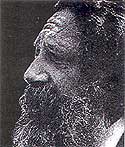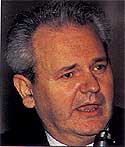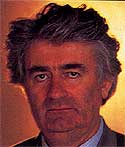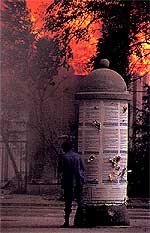The above declaration was made by Jovan Raskovic, psychiatrist, on the independent “Yutel” television channel in Belgrade. It was published in the Vreme and Vjeskik newspapers on January 24, 1992 — two months before the war broke out in Bosnia-Herzegovina.
A few months later, Raskovic died from a heart attack in Belgrade.
His work had been done. With fellow psychiatrist Radovan Karadzic, he had whipped the Serbs into a frenzy and set the stage for the Balkans’ biggest bloodbath since the area was occupied by the Nazis in World War II.
Twin Brothers of the Balkans: Contrary to circulated reports, the Serbs and the Croats have not always been at odds and are not peoples devoted to genocide.
Indeed, as Slavic peoples, they are twin brothers from the time they lived together in the remote regions of what are today Poland and Czechoslovakia. Together, they traveled south at the start of the 7th Century, settling in the Balkan Peninsula, in an area called Illyria, part of the Eastern Roman Empire.
That is why they are called Yugoslavians, meaning “South Slavs.”
The indigenous populations, partly Romanized, were pushed out or slowly absorbed.
The Croats became Roman Catholics and the Serbs became Eastern Orthodox. Together, they had to deal with various invasions. Their history, until this century, was one of subjugation by two empires and a gradual emancipation conducted, if not jointly, at least without animosity.
The Bosnians are also Southern Slavs. They came from central Europe around the same time as the Serbs and Croats and settled in the territory of today’s Bosnia-Herzegovina. Although originally primarily Christians, like the Catholic Croats and the Orthodox Serbs, the majority of Bosnians converted gradually to Islam after the arrival of the Ottoman Turks in the Balkans.
By the 1500s, the Ottomans had taken over most of the Balkans.
For centuries, in the south, most of the Serbs, the Bulgarians, the Macedonian Slavs, the Albanians and the Bosnians were under their dominion.
In the north, the Slovenians, most of the Croats, and the regions of Slavonia and Vojvodina became part of the Austrian Empire.
The Slavs suffered more under the Ottoman Empire than under the Austrian Empire, leading to a significant emigration of Serbs to the west and the north, along the borders of today’s Croatia and Vojvodina.
“Yugoslavia” Forms: This phenomenon of Serbian emigration was encouraged by the Austrians, since the Serbs provided a buffer against Turkish invasions. The Serbs enjoyed a rather privileged status at the time.
Later, at the beginning of the 19th century, the Serbs were the first to emancipate themselves from the Ottomans.
After Napoleon’s victory in 1809 at Wagram over the Austrians, he annexed part of the region of Illyria along the northeastern coast of the Adriatic Sea and the ideas of the French Revolution reached the Balkans. This was the era in which the idea of a united “Yugoslavia” took hold, federating all newly independent Southern Slavs.
At the time, the Serbs were the leaders of the movement to free the Slavs. They were admired by all subjugated peoples on the Balkans.
The movement for unity was interrupted on June 28, 1914, when Austrian Archduke Franz Ferdinand was assassinated in Sarajevo in Bosnia by a young Serb. The resulting turmoil brought about the First World War.
After the war, the Kingdom of the Serbs, Croats, and the Slovenes was formed from the former Slavic provinces. This name was later changed to Yugoslavia.
|
THESE MEN PLUNGED YUGOSLAVIA INTO A BLOODBATH
|

|

|

|
|
The devastation in the region can be traced to the actions of psychiatrists Jovan Raskovic (left) and Radovan Karadzic (right), as well as Slobodan Milosevic (center), a close friend of Karadzic’s and reportedly his former patient.
|
Psychiatric Atrocities Begin Under Nazi Domination: In 1941, Yugoslavia was invaded by the Nazis and divided between Germany, Italy and a small local group of fascists put into power by the Nazis called the Ustashi.
The “Independence State of Croatia” was created and became an ally of the Axis Powers (Germany, Italy and Japan) during World War II.
During this period, Croatia’s minister of the interior, Andrija Artukovic, carried out “racial purity” programs against Serbs, Jews, Gypsies and other ethnic minorities in alignment with the Nazi campaigns of “racial purity” — campaigns which were spawned and led by Nazi psychiatrists.1
Artukovic had more than 20 concentration camps constructed in Croatia and had hundreds of thousands of people tortured or executed.
The victims of this “cleansing” were 600,000 Serbs, Jews, Gypsies, Croats, Muslims and virtually anyone who didn’t agree to cooperate with the Nazis. They were exterminated by the Ustashi in the name of psychiatric theories.
After the war, a resistance leader, Marshal Tito, unified Yugoslavia, imposing a communist government which lasted for more than 40 years.
After the death of Tito in 1980, a number of politicians, including Dobrica Cosic and Slobodan Milosevic, vied for power.
“Greater Serbia”: Dobrica Cosic had been a militant communist, currying an image he had created as a fighter during World War II. However, after Tito’s death, Cosic quickly understood that communism as administered by Tito no longer had a future in Yugoslavia.
In 1986, Cosic, a member of the academy of Sciences in Belgrade and several other prominent academics published what they called the “Memorandum.”
This 20-page booklet was the statement of intent and organizational plan for the creation of an independent “Greater Serbia” from portions of Yugoslavia.
Cosic has been the president of the Yugoslavian Federation (consisting of Serbia and Montenegro) since 1992.
Slobodan Milosevic, leader of the Communist Party in Serbia, began to play on Serbian nationalism and the call for a Greater Serbia.
His rising popularity with the Serbs followed his comments in 1987 which inflamed Serbs in the Yugoslavian state of Kosovo and later led to protests and strikes by local Serbs which Milosevic openly supported and encouraged.
Kosovo, located in the south of Serbia, has a population which is about 90 percent Albanian.
The Man Who Lit the Fuse: Jovan Raskovic was a Croatian Serb, a friend of Cosic and a member of the Communist Party (renamed the Serbian Socialist party). Earlier in his career, he had publicly supported Soviet dictator Joseph Stalin against Tito.
Raskovic was also a psychiatrist, practicing at the Neuropsychiatric Clinic in Sibenik, Croatia, near the southern border of Bosnia-Herzegovina.
In 1990, Raskovic became a member of the Academy of Sciences of Serbia, where he joined Cosic and others who had signed the Memorandum.

At right, Sarajevo burning.
|
Covert Plot: The inhabitants of Raskovic’s hometown, Primosten, a city in the Bil region of Croatia, said that when the Memorandum was being written, Cosic and the others who signed the document frequently visited Raskovic’s house.
Although Raskovic helped to bring about the Memorandum, he did not sign it.
After its publication, citizens of Primosten printed an open letter to Raskovic:
“Raskovic needs to move from Bil....
“We have been profoundly humiliated by you. We hope you understand that you have no place among us.
“In our city of Primosten, as published by the press, the famous Memorandum of the Serbian Academy of Sciences was written, planning the creation of a greater Serbia. You received here the founders of the New Empire which wanted to take over the territories of others and our region almost became part of this New Empire.”
Psychiatrist of the “Mad Country”: On October 17, 1991, a colleague of Raskovic’s in Sibenik, psychiatrist Boris Zmijanovic, described Raskovic in the newspaper Nedjeljina Dalmacija:
“He was a practicing psychiatrist, who...used electroshocks and other sadistic psychotherapeutic methods with particular pleasure in the case of Croats, especially Croatian women. This shows what kind of man he was.”
In his clinic, Raskovic gave electroshocks to his patients, including children.
It was while practicing at Sibenik that Raskovic began to exalt the Croatian Serbs, telling them about horrors committed against them by the Ustashi during World War II.
To whip them into action, he spoke endlessly about the concentration camps which had been built by the Ustashi and the “genocidal instinct” of the Croatian people.
|
“He [Raskovic] was a practicing psychiatrist, who... used electroshocks and other sadistic psychotherapeutic methods with particular pleasure in the case of Croats, especially Croatian women.”
|
Then, in 1990, Raskovic published a book entitled
Luda Zemlja (A Mad Country). After opening the book with reminders of the genocide campaign carried out against the Serbs during the Second World War and gaining the reader’s sympathy, Raskovic explains his psychoanalytic theories about the different ethnic groups in Yugoslavia — theories he claimed he had discovered from his psychiatric practice.
Raskovic stated that the Croats have a fear of castration and are afraid of everything, and therefore cannot assert themselves or exercise authority or leadership. They must therefore be “guided.”
He claimed that the Muslims have an “anal erotic fixation” and a compulsion for acquiring assets and money.
He then asserted that the Serbs are the only people ever to overcome the Oedipus complex2 and dare to stand up to and “kill” the father. Raskovic asserted that this is why the Serbs are the only group with a sense of authority and why they must exert that authority over the other Yugoslavian peoples. They must dominate them.
Raskovic hawked his book and spread his psychiatric theories throughout the country in newspapers and on television as part of a media campaign in which he was presented as the great psychiatrist and scientist of his era.
continued
1 For a discussion of the instrumental role played by psychiatry in Nazi racial hygiene and extermination programs, see “Prozac Under Fire,” FREEDOM, October 1991
2 In psychoanalytic theory, an Oedipus complex is a strong childhood attachment for the parent of the opposite sex, often accompanied by a feeling of rivalry, hostility, or fear toward the other parent.

|

